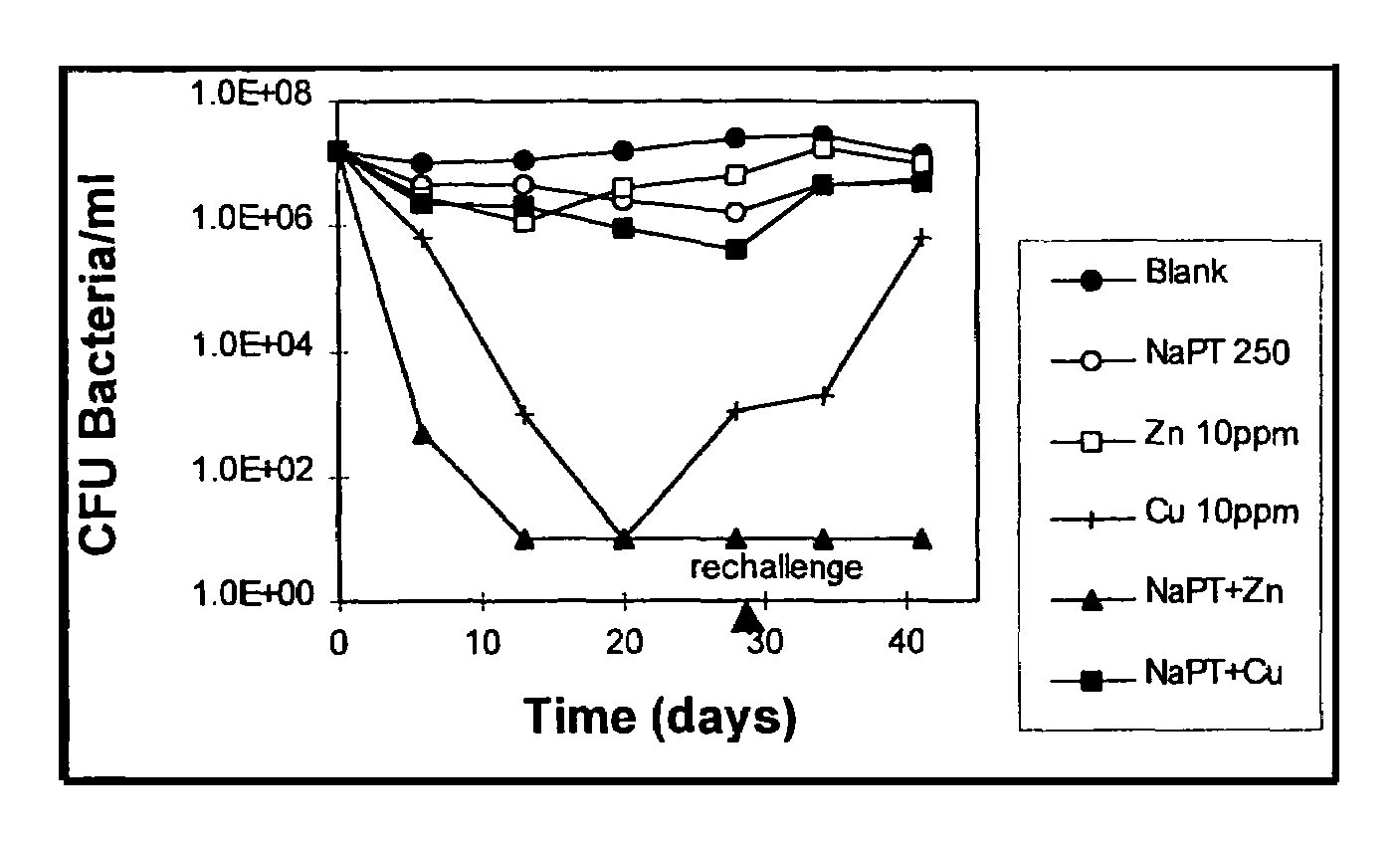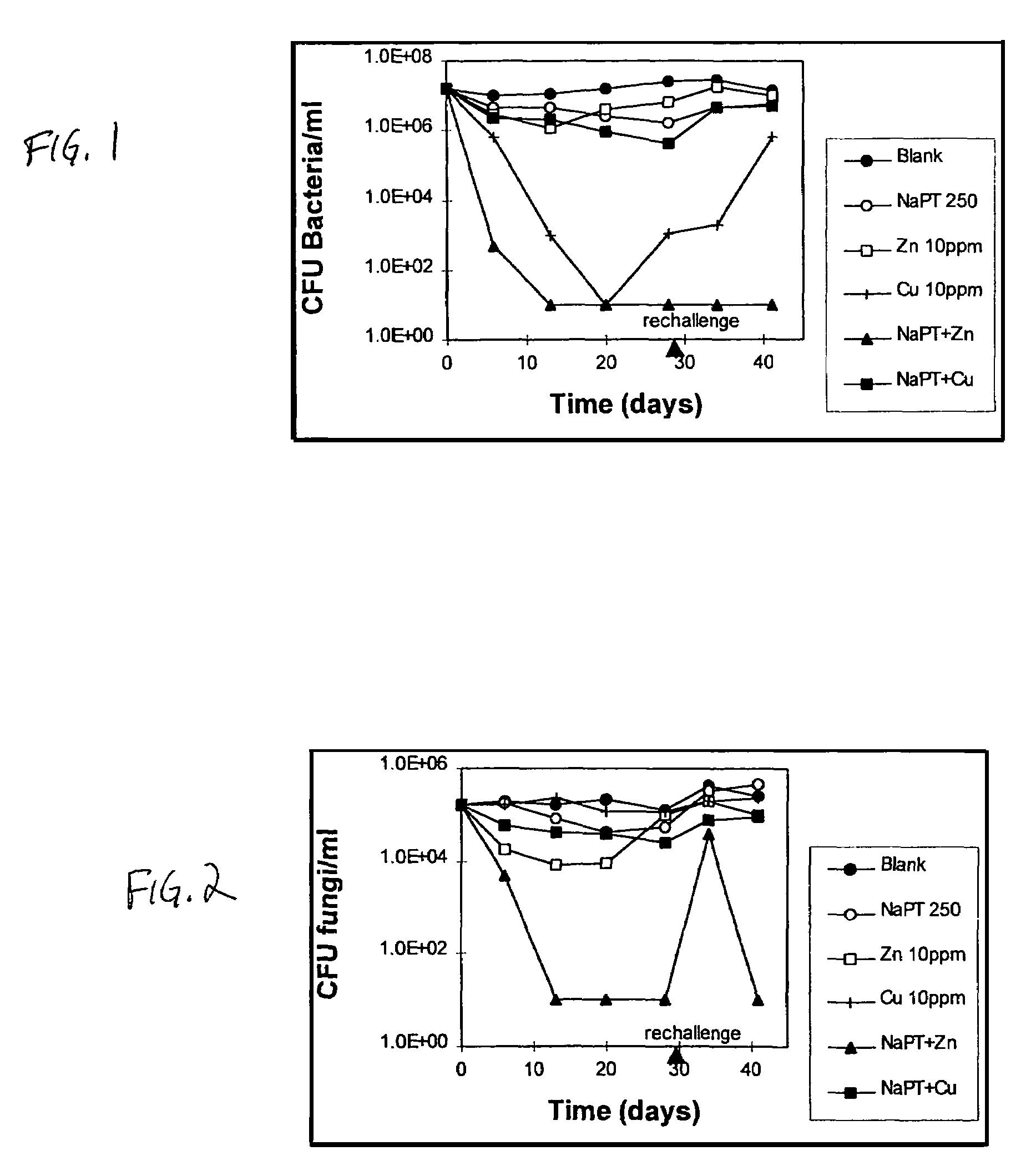Pyrithione biocides enhanced by silver, copper, or zinc ions
a biocide and pyrithione technology, applied in the field of pyrithione biocides, can solve the problems of limited commercial product use of pyrithione or its salts, limited efficacy and economic considerations, compounds that do not possess the high biocidal efficacy that is desired in many commercial applications, etc., to achieve enhanced biocidal effect enhanced biocidal
- Summary
- Abstract
- Description
- Claims
- Application Information
AI Technical Summary
Benefits of technology
Problems solved by technology
Method used
Image
Examples
example 1
The Effect of 0.5 ppm Cu (II) on the Minimum Inhibitory Concentration (MIC) of Sodium Pyrithione (NaPT)
[0074]NaPT and copper pyrithione (CuPT2) were serially diluted in microtiter plates in Tryptic Soy Broth (TSB). NaPT was also diluted in TSB amended with 1 ppm of Cu (II) (CuSO4.5H2O). Equal volumes of bacterial suspension (106 bacteria per milliliter of TSB) containing Pseudomonas aeruginosa ATCC 9027 or fungal spore suspension (105 spores per milliliter of TSB) containing Aspergillus niger ATCC 6275 or species of Fusarium and Cephalosporium isolated from contaminated metalworking fluid were added to each microtiter plate well, and the plates were incubated at 28° C. Controls were prepared for cultures inoculated into TSB with and without Cu (II). After a period of 4 to 8 days, the lowest concentration of biocide causing the inhibition of visible growth was observed. The results are shown in Table 1.
[0075]As shown in Table 1, Cu (II) had no effect by itself or on the MIC of NaPT a...
example 2
Interactions of Pyrithione Salts and Zn(II) Ion: Zone of Inhibition Test
[0078]Cultures of bacteria were grown for 24 hr. on Tryptic Soy Agar (TSA), and suspensions containing 108 cells per milliliter of sterile water were prepared. TSA plates were inoculated with sterile cotton swabs, and sterile 6.5 mm paper discs soaked with solutions containing solutions of 0.135% pyrithione (NaPT and the MgSO4.3H2O adduct of 2,2′-dithiopyridine-1,1′-dioxide (MDS) in water, or zinc pyrithione (ZPT) in dimethylsulfoxide (DMSO)), 0.10% ZnCl2, or a 1:1 molar mixture of pyrithione and ZnCl2. The discs were applied, and the plates were incubated at 28° C. for 24 hr. The diameter of each zone of inhibition was measured with a ruler. The results are shown in Table 2.
[0079]As shown in Table 2, zinc chloride, by itself produced no zone of inhibition for any of the three cultures and decreased the zone of inhibition for some mixtures, but it increased the zone of inhibition of MDS for Pseudomonas aeruginos...
example 3
Interactions of Pyrithione Salts and Zn(II) and
Ag(I) Ion: Checkerboard Minimum Inhibitory Concentration Test
[0081]Mixtures of pyrithione and zinc or silver in various proportions were tested for relative efficacy by a modification of the procedure described by Dougherty, et al.
[0082]To evaluate Zn ion (Table 3a), aqueous stock solutions of pyrithione and zinc salts (ZnSO4 or ZnO) and mixtures of the two were serially diluted in TSB in microtiter plates. Equal volumes of bacteria (106 cells / ml) or fungi (105 spores / ml) were added to each microtiter plate well. The plates were incubated at 28 C for 3 days (bacteria) or 5 days (fungi), and the minimum inhibitory concentration (MIC) of biocide was determined. The Fractional Inhibitory Concentration (FIC=concentration of biocide in an inhibitory mixture divided by the MIC of the pure biocide) was determined, and the FIC Index (sum of the two FIC's) was calculated. The type of interaction was categorized according to the magnitude of the ...
PUM
| Property | Measurement | Unit |
|---|---|---|
| pH | aaaaa | aaaaa |
| pH | aaaaa | aaaaa |
| surface area | aaaaa | aaaaa |
Abstract
Description
Claims
Application Information
 Login to View More
Login to View More - R&D
- Intellectual Property
- Life Sciences
- Materials
- Tech Scout
- Unparalleled Data Quality
- Higher Quality Content
- 60% Fewer Hallucinations
Browse by: Latest US Patents, China's latest patents, Technical Efficacy Thesaurus, Application Domain, Technology Topic, Popular Technical Reports.
© 2025 PatSnap. All rights reserved.Legal|Privacy policy|Modern Slavery Act Transparency Statement|Sitemap|About US| Contact US: help@patsnap.com


